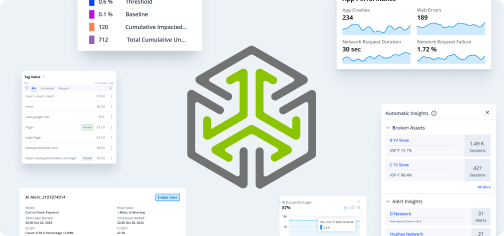Quality of Service (QoS) is essential for managing and optimizing the performance of applications and video streaming services across a network. It plays a key role in modern network management by prioritizing and regulating data traffic to ensure that critical applications, users, or data flows receive the resources they need to function efficiently. In environments with limited bandwidth or high traffic volumes, QoS ensures that high-priority data, such as real-time video or mission-critical applications, is given preference, while lower-priority traffic may be delayed or restricted to prevent congestion. This approach allows organizations to optimize their network resources and maintain smooth operations, even during periods of peak usage.
As applications and video streaming increasingly dominate digital experiences, delivering consistent and high-quality performance is crucial for ensuring user satisfaction. QoS achieves this by allocating network resources efficiently, managing data flow, reducing latency, and preventing disruptions caused by congestion or bandwidth limitations, thereby ensuring seamless service delivery.
Quality of Service Parameters
Organizations assess Quality of Service quantitatively by analyzing a variety of key parameters that provide detailed insights into network performance. By monitoring these parameters, organizations can evaluate how well the network is supporting different types of traffic and applications, ensuring that high-priority services receive the necessary resources for optimal performance.
1. Packet Loss
Packet loss occurs when network links are overwhelmed, leading routers and switches to drop packets. This often happens due to network congestion, where the volume of data exceeds the network’s capacity to handle it efficiently. As a result, packets waiting to be transmitted can accumulate in queues. When these queues become overloaded, packets are discarded, leading to packet loss. This loss of data can degrade network performance and affect the quality of applications such as video streaming or online gaming, where real-time data transmission is crucial for user experience.
2. Jitter
Network congestion, timing drift, and route changes can result in jitter, which occurs when there is an inconsistent pace in packet transmission. On a congested network, packets may arrive late or out of order, disrupting the smooth flow of data. Excessive jitter can negatively impact real-time applications, such as audio and video streaming, causing interruptions or distortions in playback with choppy audio or laggy video feeds. Managing jitter is essential to maintaining high-quality service performance.
3. Latency
Latency refers to the time it takes for a packet to travel from its origin to its destination, and ideally, this delay should be minimized as much as possible. Latency can be significantly impacted by queuing delays, which occur during network congestion when packets are forced to wait in line for transmission. To address this, QoS mechanisms are employed to prioritize certain types of traffic, ensuring that critical data is transmitted with minimal delay. By utilizing dedicated queues for high-priority traffic, QoS helps reduce latency and maintain efficient network performance.
4. Bandwidth
Bandwidth refers to the maximum amount of data that can be transferred between two points on a network within a given timeframe. To optimize network efficiency, QoS plays a critical role by allocating more bandwidth to high-priority applications that require stricter performance standards, such as video conferencing or real-time data processing. This ensures that essential applications receive the resources they need, while lower-priority traffic is managed appropriately, allowing for a balanced and efficient distribution of network resources. By doing so, QoS helps maintain overall network performance, even during times of heavy usage or congestion.
How Quality of Service Works
Quality of Service works by using certain techniques to manage network traffic, ensuring that critical applications receive the necessary resources while minimizing delays and congestion across the network. Some of these techniques include:
- Traffic Classification and Prioritization
Quality of Service begins by categorizing various types of network traffic based on their importance and performance needs. For example, video streams, real-time applications, and general data transfers are each placed into distinct categories. Once the traffic is classified, QoS gives priority to high-demand services which ensures that critical services receive the necessary resources, even during periods of network congestion, to maintain optimal performance and prevent interruptions.
- Queuing Mechanisms
QoS tools use a range of queuing techniques to effectively manage network traffic. High-priority data is placed at the front of the queue, ensuring that it is transmitted before lower-priority traffic, which helps prevent delays in critical applications such as video services or real-time communication. Common queuing mechanisms in QoS include Weighted Fair Queuing (WFQ) and Priority Queuing (PQ), which balance the network load by assigning traffic priority based on its importance. These techniques ensure that essential services receive timely bandwidth, maintaining smooth and efficient network performance even during high-demand periods.
- Packet Scheduling
Once network traffic is classified and queued, packet scheduling is used to determine the order in which packets are transmitted. In a QoS-enabled system, packets from high-priority applications and services are scheduled for quicker transmission compared to non-critical data. This ensures that essential services, such as video streaming or real-time communication, avoid delays and experience smooth playback.
- Bandwidth Management
Quality of Service dynamically allocates bandwidth by adjusting resource distribution based on current network load and the specific requirements of the services in use. For applications and video streaming, this means that even during periods of heavy demand on the network, QoS ensures that sufficient bandwidth is reserved to maintain smooth performance. By continuously monitoring the network conditions and adapting resource allocation accordingly, QoS helps prevent disruptions and ensures that critical services operate efficiently, providing users with a reliable experience regardless of the overall network activity.
- Traffic Policing and Shaping
To prevent network overload, QoS can shape traffic by smoothing out bursts of data and enforcing bandwidth limits. For video services, this is particularly important as it helps prevent large spikes in data from overwhelming the network, ensuring a consistent flow of video data for uninterrupted playback. Additionally, traffic policing plays a critical role by ensuring that no service exceeds its allocated bandwidth, which helps to prevent congestion and promotes fair resource distribution among all users. By managing data flow and enforcing bandwidth constraints, QoS contributes to a more reliable and efficient network environment.
The Role of Quality of Service in Applications
Applications that demand real-time responsiveness rely heavily on dependable network connections to deliver a positive user experience. QoS plays an essential role in ensuring that these applications perform as expected, even when network resources are constrained or experiencing high levels of demand.
1. Latency Sensitivity
When a user engages with an application, even a minor delay in purchasing an item or logging into their account can significantly impact their experience, resulting in frustration and a decline in brand loyalty. To address this issue, QoS prioritizes data packets from these latency-sensitive applications, effectively minimizing delays and ensuring smooth, real-time interactions. By giving precedence to latency-sensitive traffic over less critical data, QoS reduces lag and helps maintain the responsiveness and performance that users expect, ultimately enhancing overall satisfaction with the application.
2. Bandwidth Allocation
Different applications have varying bandwidth requirements to operate effectively. High-demand applications, such as file-sharing or cloud-based services, can place a significant strain on network resources if not managed properly. For example, applications that handle large file transfers or backups can consume a substantial amount of bandwidth, potentially slowing down the performance of other applications on the network.
QoS addresses this issue by managing bandwidth allocation, ensuring that these resource-intensive applications do not monopolize network capacity. QoS allocates bandwidth based on priority, providing essential applications with more resources while limiting less critical traffic. This approach helps prevent bottlenecks and ensures that critical applications continue to run smoothly without interruptions.
3. Preventing Data Packet Loss
Data packets can occasionally be lost or delayed during transmission, leading to glitches or interruptions in application performance. To address this, QoS implements error correction techniques that help ensure critical packets reach their destination without loss. By minimizing packet loss and delays, QoS helps maintain consistent functionality, ensuring that applications perform reliably and without disruptions.
4. Traffic Shaping and Control
QoS helps manage network traffic by smoothing out data flows and preventing large spikes from overwhelming the network. This process, known as traffic shaping, ensures that applications requiring a consistent data stream receive a steady flow of information. By maintaining this balance, QoS improves the responsiveness and overall performance of these applications, ensuring they operate effectively.
The Role of Quality of Service in Video Streaming
Video streaming is among the most data-heavy activities online, consuming significant bandwidth. Quality of Service is crucial for ensuring seamless and uninterrupted video delivery. Whether it’s live streaming, video-on-demand, or video conferencing, QoS plays a key role in managing the high network demands video places on infrastructure, ensuring optimal performance and minimal disruptions.
1. Reducing Buffering and Load Times
A major challenge for video streaming services is buffering and slow load times, which can create a frustrating user experience. Video streaming depends on a continuous flow of data, and without QoS, network congestion can result in delays, buffering, and reduced video quality. QoS addresses these issues by prioritizing video traffic and allocating sufficient bandwidth to ensure smooth, uninterrupted playback. By managing the flow of video data and giving it priority over less time-sensitive traffic, QoS helps deliver a seamless streaming experience with minimal disruptions.
2. Ensuring High Quality Video Resolution
Video quality is often adjusted dynamically based on the available bandwidth, but without QoS, network congestion can cause video services to lower the resolution or quality in order to keep playback smooth. QoS prevents this degradation by ensuring that sufficient bandwidth is allocated to video streams, enabling high-definition or even 4K resolution on capable devices. By prioritizing video packets, QoS helps maintain high-quality video playback, reducing the chances that streams will be downgraded to lower resolutions due to bandwidth constraints.
3. Minimizing Latency for Live Streaming
Latency is a critical concern for live streaming, particularly when real-time interaction is essential, such as during major live events watched by millions. To address this concern, QoS prioritizes live video packets, ensuring they are delivered to viewers with minimal delay. This helps maintain smooth, real-time interaction, creating a more engaging and seamless viewing experience. By reducing the risk of delays or disruptions during important events, QoS ensures that live streams run efficiently and deliver content as intended.
4. Traffic Management
Video platforms often manage millions of simultaneous streams and experience fluctuations in demand, particularly during peak times or live events. To maintain consistent delivery of video content, QoS can “shape” traffic, ensuring smooth performance even under heavy load. By controlling the rate at which video data is transmitted, QoS minimizes the effects of network congestion, preventing quality degradation. This approach allows platforms to prioritize video data and prevent bottlenecks, ensuring that users continue to enjoy high-quality streams, even during periods of peak usage.
Why is Quality of Service Important?
Without Quality of Service, network traffic can become disorganized and chaotic, leading to severe congestion that degrades overall performance or, in some cases, causes complete network failure. Applications involving audio and video content are especially vulnerable, as they require high-speed, uninterrupted data transmission without packet loss or variations in delivery speed. QoS is essential for ensuring the high performance of critical, real-time applications that demand significant bandwidth. By prioritizing and managing these traffic flows, QoS helps businesses prevent delays, guaranteeing that sensitive applications perform to the level users expect.
In today’s digital landscape, applications and digital services consume vast amounts of bandwidth, and users demand consistently high performance at all times. Organizations must deploy advanced techniques like QoS to ensure that their services meet these expectations, as poor performance can impact user satisfaction and Quality of Experience (QoE). For example, a high Connection Induced Rebuffering Ratio (CIRR) during video streaming can negatively affect how users perceive a brand, potentially damaging customer relationships and revenue. Furthermore, inadequate QoS increases the risk of data integrity issues and compromises network security, making it even more crucial for businesses to prioritize performance management.
Benefits of Quality of Service
Quality of Service provides a range of advantages that significantly improve both network efficiency and user experience. Some notable examples include:
- Improved User Experience
QoS plays a crucial role in providing users with a consistent, high-quality, and seamless experience while using applications and streaming video. By prioritizing time-sensitive data and effectively preventing network congestion, QoS minimizes issues such as delays, buffering, lag, and crashes. This proactive management of data flow leads to greater user satisfaction and engagement, ultimately enhancing overall business performance.
- Efficient Use of Network Resources
QoS enables businesses to optimize the utilization of their existing network infrastructure effectively. Rather than resorting to over-provisioning bandwidth to accommodate occasional spikes in demand, QoS ensures that the available bandwidth is utilized more efficiently. By prioritizing critical services and controlling less important traffic, organizations can allocate resources where they are most needed. This approach not only helps in maintaining optimal performance but also leads to significant cost savings.
- Reduced Downtime and Faster Issue Resolution
By closely monitoring traffic patterns and prioritizing critical services, QoS significantly mitigates the risk of network downtime and service interruptions. In the event of a network issue, QoS enables faster identification and isolation of the problem, which facilitates quicker resolution. This proactive approach minimizes the impact on applications and video services, ensuring fewer disruptions for users and maintaining overall service quality.
- Scalability
As businesses and consumers become increasingly dependent on digital services, QoS delivers the necessary scalability to effectively manage rising network demands. Whether it’s accommodating larger audiences for video services or supporting a greater number of applications on the network, QoS plays a crucial role in ensuring that performance remains consistent even as demand escalates. This adaptability enables organizations to provide high-quality experiences without compromising on service delivery, regardless of user load.
How to Implement Quality of Service
When implementing Quality of Service tools and tools and strategies, organizations should follow a structured and thoughtful approach to ensure optimal performance and successful integration into their network environments. This process involves five key steps: planning, design, testing, deployment, and monitoring.
Planning is the first step in QoS implementation. Organizations need to start by thoroughly understanding the specific service needs and requirements of each department or business unit. This includes identifying which applications and services are mission-critical and require prioritized network performance. Once the needs are clear, the next part of planning involves selecting the appropriate QoS model. Various models, such as Differentiated Services (DiffServ) or Integrated Services (IntServ), offer different approaches to traffic management.
In the design phase, the organization applies the selected QoS model to the specifics of its network architecture. This involves taking note of all significant hardware and software components that will be affected by the QoS implementation, such as routers, switches, and firewalls. The design phase ensures that all critical network elements are prepared for QoS configurations, and it includes mapping out how traffic will be classified and prioritized.
Once the design is complete, the organization enters the testing phase. During this step, QoS settings and policies should be tested in a controlled environment that simulates real-world network conditions. This isolated testing ensures that any potential issues or bugs can be identified and resolved before rolling out the policies across the production network. Testing also allows for fine-tuning of QoS rules to ensure that traffic is prioritized correctly, and latency-sensitive applications are performing as expected.
After successful testing, the next step is deployment. It’s recommended to deploy QoS policies in phases rather than all at once, to minimize disruption and ensure a smooth transition. Organizations may choose to roll out policies by network segment, prioritizing certain departments or areas of the network that need immediate attention. Phased deployment allows for close monitoring of how the new policies affect network performance and user experience in real-time, and it provides opportunities to make adjustments before fully implementing QoS across the entire network.
Finally, monitoring and analysis are essential for ensuring that QoS policies continue to perform as expected. After deployment, the organization should continually collect and analyze performance data to determine if the QoS policies are achieving the desired results. This involves monitoring metrics like bandwidth usage, latency, jitter, and packet loss to identify any areas where policies may need adjustment. Based on this data, teams can fine-tune QoS configurations to further improve performance, ensuring that critical applications maintain the highest levels of service quality and that the network remains efficient and responsive over time. Regular monitoring also helps identify emerging needs or changes in traffic patterns, allowing for proactive adjustments to the QoS strategy.
Differences Between Quality of Service and Quality of Experience
Quality of Service (QoS) and Quality of Experience (QoE) are both essential metrics for evaluating the performance of digital services, yet they assess different facets of that performance. QoS pertains to the technical performance of a network, emphasizing quantifiable metrics such as bandwidth, latency, jitter, and packet loss. It focuses on managing and prioritizing network traffic to ensure that applications with stringent performance requirements receive the necessary resources to operate smoothly. Essentially, QoS is concerned with optimizing the underlying infrastructure to maintain consistent service delivery.
In contrast, QoE centers on the end user’s perception of the service, evaluating their experience based on factors like ease of use, reliability, and overall satisfaction. While QoS addresses the technical efficiency of a network, QoE is inherently more subjective, relying on how users perceive the functionality and responsiveness of applications or services. Notably, high QoS does not always guarantee high QoE; a network may perform excellently from a technical standpoint, but if the user interface is complicated or the service is inconsistent, user satisfaction may still be low. Thus, while QoS focuses on maintaining network performance, QoE aims to ensure user satisfaction, and both are crucial for delivering a seamless and reliable digital experience.
Quality of Service Best Practices
To successfully implement Quality of Service, organizations should follow a set of best practices that ensure consistent performance, efficient bandwidth usage, and a positive experience for end-users. These best practices are designed to optimize network traffic management, prioritize critical applications, and maintain smooth operations even under heavy load. Below are some key best practices for effectively implementing QoS in a network environment.
- Prioritize Critical Applications and Services
One of the core objectives of QoS is to ensure that applications have the necessary bandwidth and network performance to function without disruption. To achieve this, it’s important to prioritize these applications over less time-sensitive traffic, such as file downloads or web browsing. It’s essential to map out traffic classification rules that can differentiate between various applications and assign DSCP (Differentiated Services Code Point) or Class of Service (CoS) values. These network protocols allow routers and switches to prioritize traffic at the packet level, ensuring that high-priority packets are processed first, reducing delays for sensitive traffic like voice and video.
- Apply Bandwidth Management Techniques
Effective bandwidth management is a crucial component of QoS. Implementing strategies such as traffic shaping and traffic policing can help control the flow of data and prevent network congestion, which can severely degrade performance for time-sensitive applications.
Traffic shaping smooths out traffic by controlling the rate at which data is sent to the network. It helps prevent sudden spikes in traffic from overwhelming the network, which is particularly useful when dealing with large file transfers or cloud synchronization services. Shaping allows the network to process traffic more evenly, ensuring that high-priority applications are not affected by congestion caused by bulk data transmissions.
Traffic policing involves setting strict limits on the amount of bandwidth available to different types of traffic. For example, you can cap the bandwidth usage of low-priority traffic to ensure that it doesn’t consume excessive resources during peak times. Traffic policing helps ensure that non-critical applications don’t interfere with more essential services and contributes to maintaining overall network stability.
- Monitor and Adjust QoS Policies Regularly
QoS requires continuous monitoring and periodic adjustments to stay effective. Network conditions, user behavior, and application requirements can change over time, so it’s essential to monitor the performance of QoS policies using network monitoring tools and performance analytics.
Monitor key performance indicators such as latency, jitter, packet loss, and throughput for high-priority applications. These KPIs provide insights into how well your QoS policies are working and whether critical traffic is receiving the necessary bandwidth and priority. If performance metrics indicate issues such as increased latency or dropped packets, you may need to adjust your QoS settings to allocate more bandwidth to critical services or fine-tune your prioritization rules.
- Ensure QoS Compatibility with All Devices and Network Segments
It is important to ensure that all devices in your network infrastructure support QoS and are configured correctly. Many modern routers, switches, and wireless access points come with built-in QoS features, but older hardware may not fully support advanced QoS capabilities. Ensure that every device along the traffic path is QoS-compatible and can process and prioritize traffic according to your policies.
Monitoring Quality of Service With Conviva’s Operational Data Platform
Conviva’s real-time performance analytics provide real-time, continuous monitoring and analysis of network data, allowing service providers to detect and address issues before they escalate. By leveraging full-census, comprehensive client-side telemetry, Conviva offers detailed visibility into network performance, enabling providers to spot anomalies and inefficiencies as they happen. This granular insight is key to improving QoS as providers can pinpoint problems such as buffering or excessive load times in a matter of seconds. Conviva’s monitoring process allows for precise action, reducing the risk of user dissatisfaction and ensuring a smoother digital experience.
Conviva’s Operational Data Platform leverages stateful experience metrics, giving service providers access to a wealth of data about the user experience across various devices, platforms, locations, and OS versions. This comprehensive data empowers businesses to understand network issues at a deeper level, quickly diagnosing user-impacting problems in real time. Whether it’s buffering, latency, or failed load attempts, providers can see exactly what is going wrong and why, easily drawing connections between Quality of Service and Quality of Experience issues to help prioritize fixes. This level of visibility is crucial for quick, effective decision-making, allowing teams to react within seconds rather than hours or days.
The power of Conviva’s ECO is amplified by its AI-driven capabilities, which analyze over 720 million metrics per hour. This massive data processing ability enables Conviva to identify patterns and anomalies with unmatched speed and accuracy. AI alerts further enhance performance management, notifying service providers of potential issues before users are affected. By preemptively addressing these concerns, providers can ensure that the network remains optimized, maintaining high performance and seamless service delivery for all users. This proactive approach helps businesses maintain customer satisfaction, reduce churn, and drive long-term success.
Precisely Evaluate Quality of Service with Conviva
QoS ensures that time-sensitive data flows smoothly, preventing disruptions that could negatively impact the end-user experience. Without effective QoS, digital businesses risk network congestion, performance degradation, and user dissatisfaction, all of which can harm their reputation and bottom line. For digital businesses looking to optimize their network performance and deliver the best possible user experience, adopting Conviva’s Operational Data Platform is a game-changer.
The detailed, stateful metrics provided by Conviva allow businesses to understand network performance at a granular level, giving them the tools needed to continually enhance QoS in relation to QoE. For organizations seeking to stay competitive in a fast-paced digital environment, Conviva’s ODP offers the insight and operational efficiency necessary to keep users satisfied and services running at peak performance. By adopting Conviva’s comprehensive monitoring solution, businesses can confidently optimize their digital infrastructure, ensuring they are well-equipped to meet current demands while preparing for future growth.




